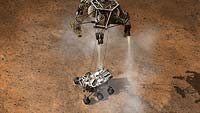|
COMETS EARTH JUPITER KUIPER BELT MARS MERCURY METEORITES NEPTUNE OORT CLOUD PLUTO SATURN SOLAR SYSTEM SPACE SUN URANUS VENUS ORDER PRINTS
PHOTO CATEGORIES SCIENCEVIEWS AMERICAN INDIAN AMPHIBIANS BIRDS BUGS FINE ART FOSSILS THE ISLANDS HISTORICAL PHOTOS MAMMALS OTHER PARKS PLANTS RELIGIOUS REPTILES SCIENCEVIEWS PRINTS
|
Related Document
Download Options
This artist's concept depicts the moment that NASA's Curiosity rover touches down onto the Martian surface. The entry, descent, and landing (EDL) phase of the Mars Science Laboratory mission begins when the spacecraft reaches the Martian atmosphere, about 81 miles (131 kilometers) above the surface of the Gale crater landing area, and ends with the rover safe and sound on the surface of Mars. Entry, descent, and landing for the Mars Science Laboratory mission will include a combination of technologies inherited from past NASA Mars missions, as well as exciting new technologies. Instead of the familiar airbag landing systems of the past Mars missions, Mars Science Laboratory will use a guided entry and a sky crane touchdown system to land the hyper-capable, massive rover. The sheer size of the Mars Science Laboratory rover (over one ton, or 900 kilograms) would preclude it from taking advantage of an airbag-assisted landing. Instead, the Mars Science Laboratory will use the sky crane touchdown system, which will be capable of delivering a much larger rover onto the surface. It will place the rover on its wheels, ready to begin its mission after thorough post-landing checkouts. The new entry, descent and landing architecture, with its use of guided entry, will allow for more precision. Where the Mars Exploration Rovers could have landed anywhere within their respective 93-mile by 12-mile (150 by 20 kilometer) landing ellipses, Mars Science Laboratory will land within a 12-mile (20-kilometer) ellipse! This high-precision delivery will open up more areas of Mars for exploration and potentially allow scientists to roam "virtually" where they have not been able to before. In the depicted scene, Curiosity is touching down onto the surface, suspended on a bridle beneath the spacecraft's descent stage as that stage controls the rate of descent with four of its eight throttle-controllable rocket engines. The rover is connected to the descent stage by three nylon tethers and by an umbilical providing a power and communication connection. When touchdown is detected, the bridle will be cut at the rover end, and the descent stage flies off to stay clear of the landing site. |
